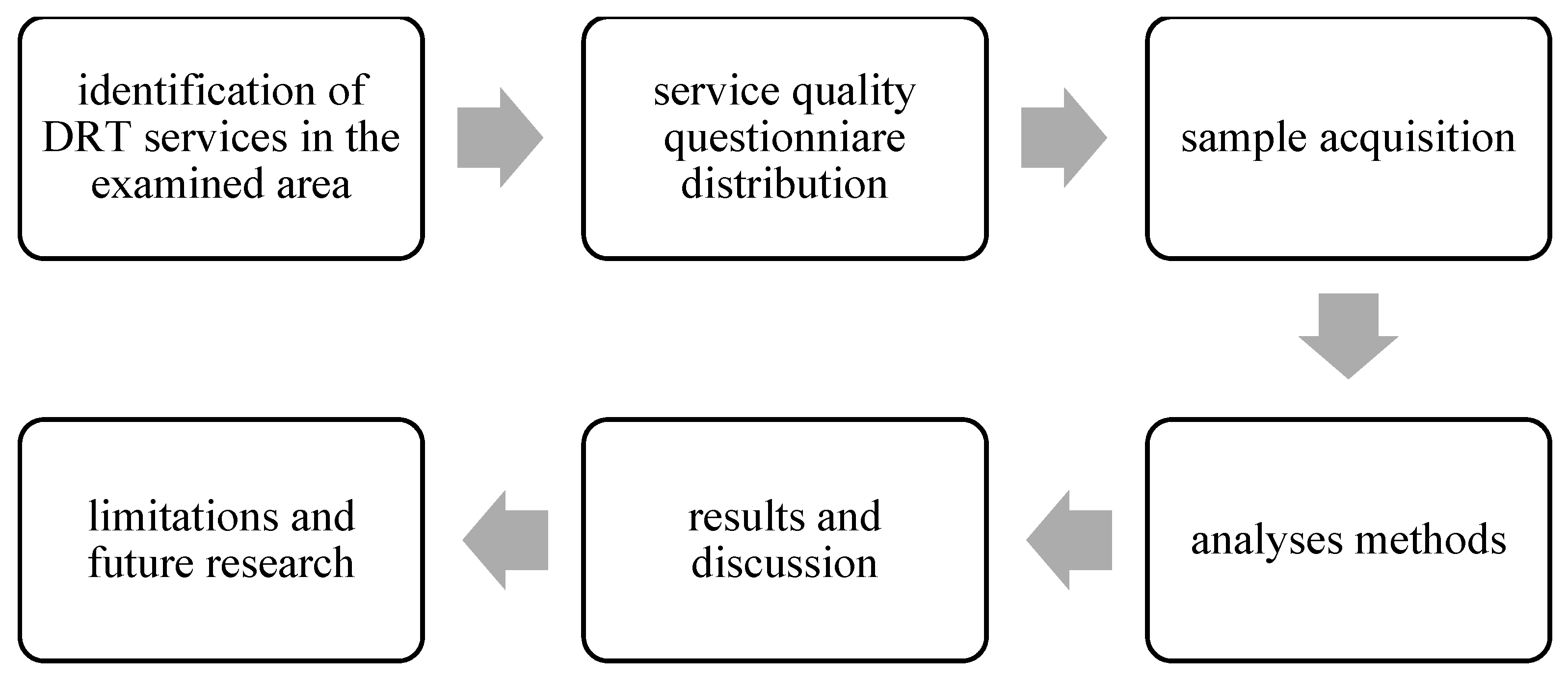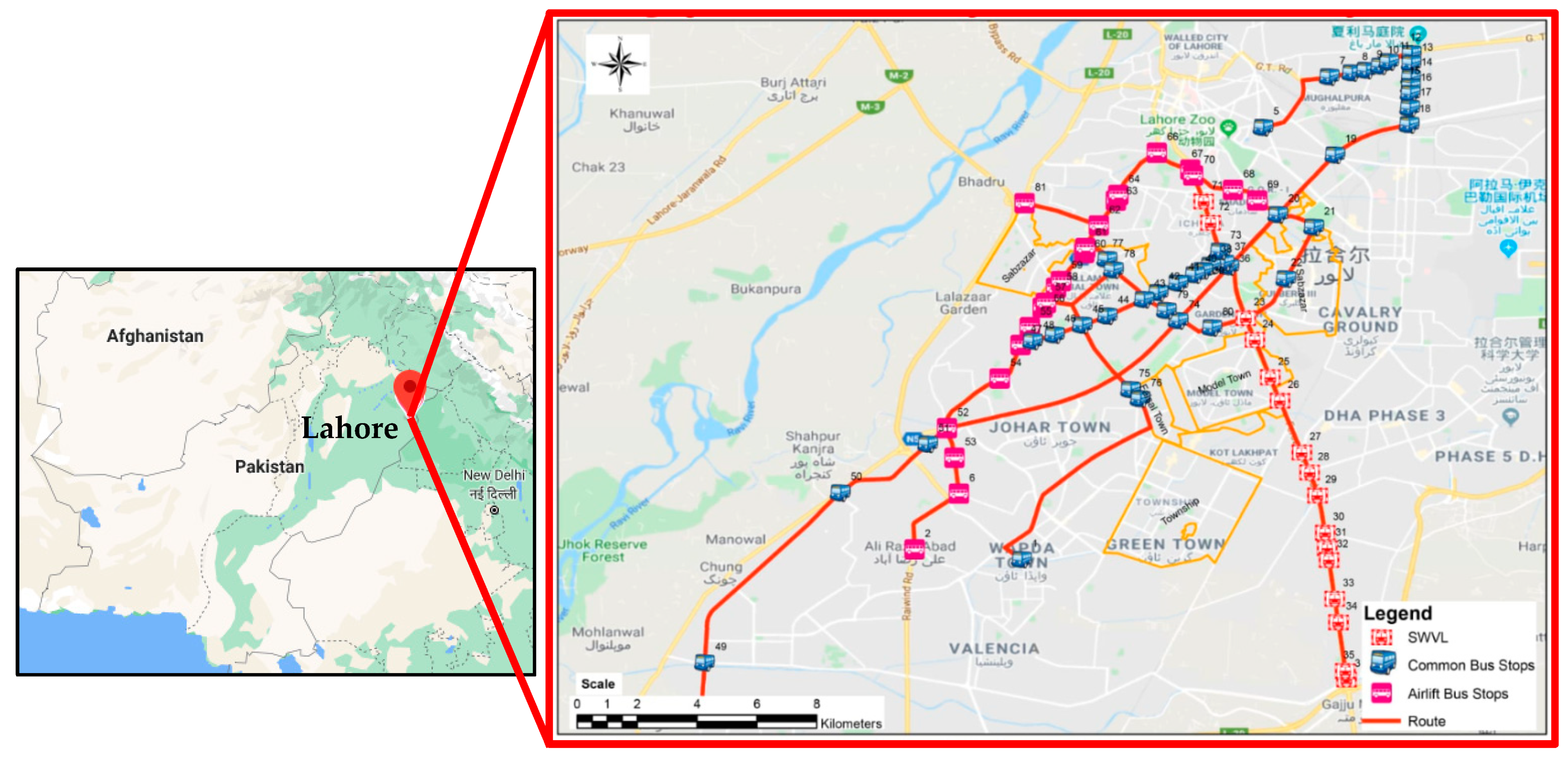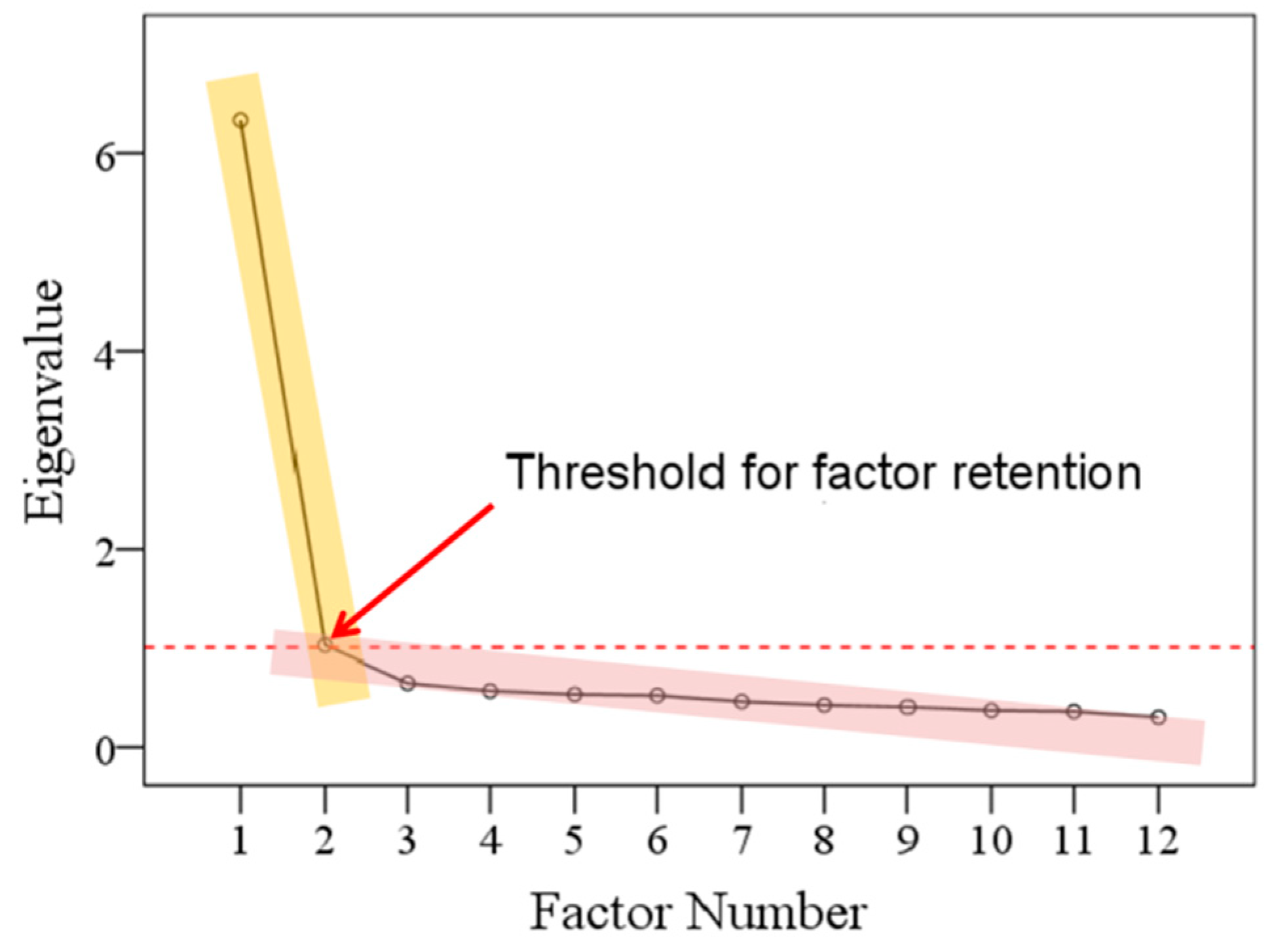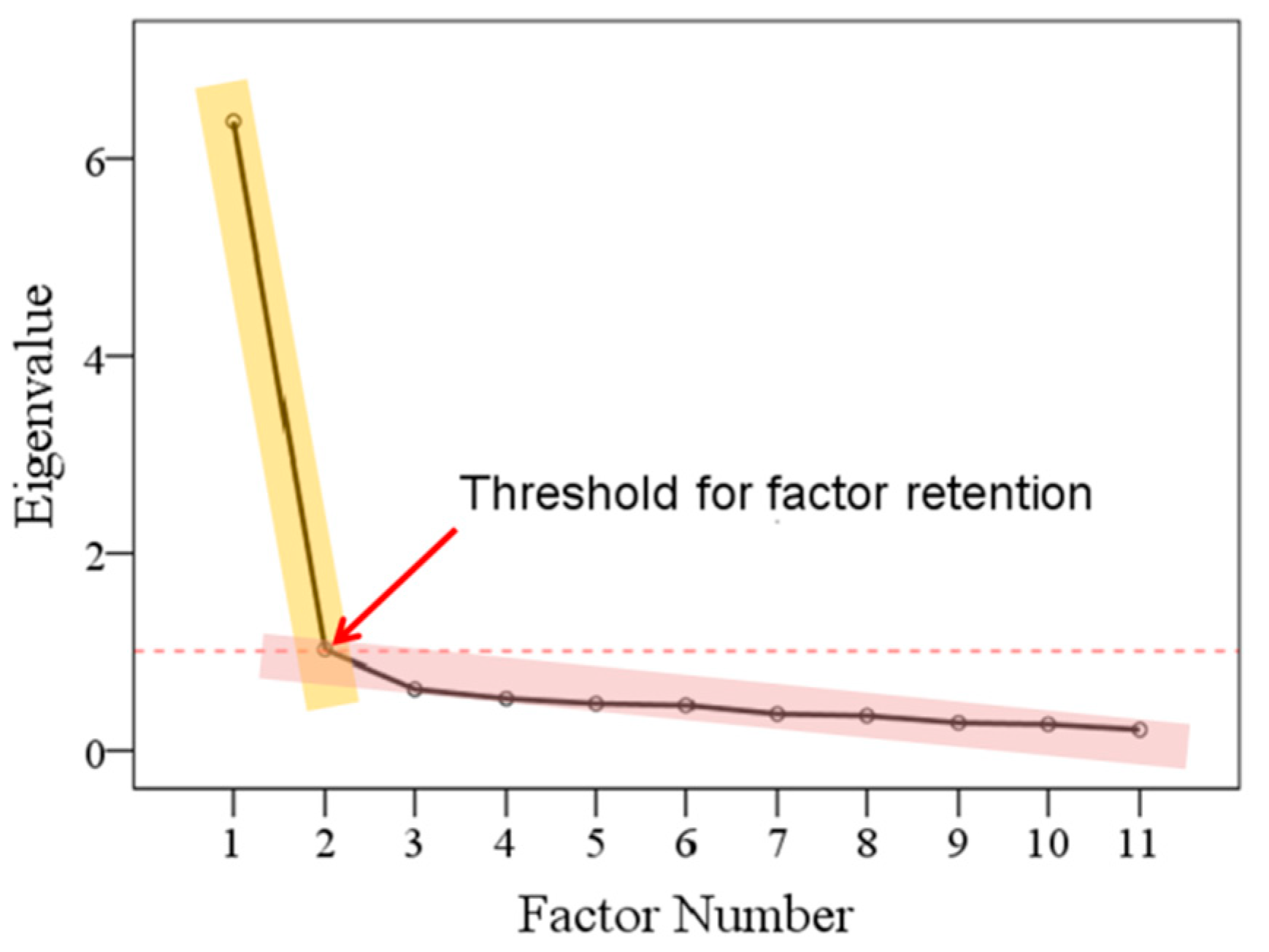4.2. Factor Analysis
SWVL (Choice A)
A two-factor solution was obtained based on eigenvalues >1 criterion, which explained about 53.84% of the total variance. However, this criterion has the tendency to produce incorrect results [
44]. Hence, a better approach is needed to determine the number of factors to retain from a scree plot [
42]. The kink in the scree plot, shown in
Figure 3, showed that it is adequate to choose a two-factor solution. Heavily cross loaded items were removed. A very high value of Cronbach’s alpha for factor 1 indicated that several items loaded on this factor were essentially measuring the same thing. Hence, highly similar items were removed.
The factor loadings are presented in
Table 3. A cut-off value of 0.5 was used for item loadings, i.e., the items with loadings below this value were removed. The sampling adequacy was satisfactory (Kaiser–Meyer–Olkin measure = 0.944), Bartlett’s test of sphericity was significant (0.000), and the determinant of the matrix was 0.002.
The first axis explained 27.457% of the total variance. The six items loaded on this factor were travel time savings, accessibility, equity, speed, incentive system, and information system. Therefore, this factor can be referred to as “service-attributes.” The second axis explained 26.383% of the total variance. The six items loaded on this axis were safety, security, cleanliness, affordability, environmental impacts, and comfort. Therefore, this factor may be referred to as the “ambience” of the bus. Cronbach’s alpha was adequate for both factors, i.e., 0.870 and 0.872, respectively, suggesting that the items have high internal consistency.
Factor scores were not normally distributed; thus, nonparametric tests such as Spearman’s correlation, Mann–Whitney U test, and Kruskal Wallis test were used for further statistical analyses. The effects of demographical attributes on the underlying factors are presented below.
Satisfaction with service-attributes (factor 1) was not statistically significantly between men and women (ZU = −0.216, p = 0.829), younger and older age groups (ZU = −0.042, p = 0.966), single and married (ZU = −0.495, p = 0.620), those with a driving license and those without (ZU = −0.100, p = 0.921), car owners and non-car owners (ZU= −0.133, p = 0.894), and motorcycle owners and non-motorcycle owners (ZU = −1.766, p = 0.077). Similarly, satisfaction with ambience (factor 2) was not statistically different between genders (ZU = −0.429, p = 0.668), younger and older age groups (ZU = −1.328, p = 0.184), single and married (ZU = −1.657, p = 0.098), those with a driving license and those without (ZU = −0.055, p = 0.956), car owners and non-car owners (ZU = −0.301, p = 0.763), and motorcycle and non-motorcycle owners (ZU = −0.525, p = 0.600).
No statistically significant correlation was found between income and satisfaction with service-attributes (rho = 0.032, p = 0.591), family members and satisfaction with service-attributes (rho = −0.035, p = 0.548), and education level and satisfaction with service-attributes (rho = −0.032. p = 0.580). Similarly, no statistically significant correlation was found between income and satisfaction with ambience (rho = 0.063, p = 0.282), family members and satisfaction ambience (rho = 0.072, p = 0.216), and education level and satisfaction with ambience (rho = −0.109, p = 0.061).
Airlift (Choice B)
A two-factor solution was obtained based on eigenvalues >1 criterion, which explained about 59.86% of the total variance. In addition, the kink in the scree plot (
Figure 4) shows that it is adequate to choose a two-factor solution. Heavily cross loaded items were removed. The factor loadings are presented in
Table 4. The items with loadings below 0.5 were removed. The sampling adequacy was satisfactory (Kaiser–Meyer–Olkin measure = 0.924), Bartlett’s test of sphericity was significant (0.000), and the determinant of the matrix was 0.001.
The first axis explained 31.281%of the total variance. The six items loaded on this factor were travel time savings, complaint handling, fare collection system, route alignment or coverage, speed, and incentive system. Therefore, this factor can be referred to as “service-attributes.” The Cronbach’s alpha for these six items was 0.892, suggesting that the items have high internal consistency. The second axis explained 28.583% of the total variance. The five items loaded on this axis were safety, security, cleanliness, affordability, and environmental impacts. Therefore, this factor may be referred to as the “ambience” of the bus. Cronbach’s alpha was adequate for these items, i.e., >0.7.
Again, factor scores were not normally distributed; therefore, nonparametric tests such as Spearman’s correlation, Mann–Whitney U test, and Kruskal Wallis test were used for further statistical analyses. The effects of demographical attributes on the underlying factors are presented below.
Satisfaction with service-attributes (factor 1) was not statistically significantly between men and women (ZU = −1.806, p = 0.071), younger and older age groups (ZU = −0.732, p = 0.464), single and married (ZU = −1.095, p = 0.273), those with a driving license and those without (ZU = −0.260, p = 0.795), car owners and non-car owners (ZU= −0.133, p = 0.894), and motorcycle owners and non-motorcycle owners (ZU = −3.330, p = 0.001). Similarly, satisfaction with ambience (factor 2) was not statistically different between genders (ZU = −1.499, p = 0.134), younger and older age groups (ZU = −1.170, p = 0.242), single and married (ZU = −1.514, p = 0.130), those with a driving license and those without (ZU = −0.374, p = 0.709), and car owners and non-car owners (ZU = −1.306, p = 0.191). Satisfaction with ambience was statistically significant different between motorcycle owners and non-motorcycle owners (ZU = −2.052, p = 0.040).
No statistically significant correlation was found between income and satisfaction with service-attributes attributes (rho = 0.013, p = 0.856), and family members and satisfaction with service-attributes (rho = −0.001, p = 0.986). There was a very weak significant correlation between education level and satisfaction with service-attributes (rho = −0.174. p = 0.013). No statistically significant correlation was found between income and satisfaction with ambience (rho = 0.082, p = 0.248), and family members and satisfaction ambience (rho = −0.018, p = 0.798). However, there was a very weak significant correlation between education level and satisfaction with ambience (rho = −0.169. p = 0.017).
4.3. Ordinal Regression
Finally, the relationship between an outcome variable and the explanatory variables was modeled. The outcome variable was the last ordinal item in section D of the questionnaire, i.e., different levels of respondents’ satisfaction with overall performance of choice A and choice B. The explanatory variables included demographic features (section A), the items in section C of the questionnaire, and the factor scores computed in
Section 3.2. Since the outcome variable was an ordinal variable, it does not make sense to assume normality and equality of variances. Hence, ordinal regression was used to model the relationship between the ordinal outcome variable and the explanatory variables. Logit function was used as the link function.
SWVL (Choice A)
Before going into the model details, it is necessary to check if the model is capable of providing suitable predictions. The significant chi-square statistic in
Table 5 shows that the model is a significant improvement over the intercept-only model. The goodness-of-fit can be determined using the Pearson statistic and Deviance statistic. The non-significant test results for Pearson statistic (χ
2 = 629.324, df = 711,
p = 0.987) and Deviance statistic (χ
2 = 356.739, df = 711,
p = 1.000) indicate that the model is a good fit to the data and the model predictions are similar [
45].
Cox and Snell, Nagelkerke, and McFadden pseudo R square measures indicate how well the model explains the variations in the data and were 0.415, 0.481, and 0.270, respectively. A pseudo R square value of 0.27 for McFadden showed an excellent fit [
46]. The non-significant chi-square statistic (χ
2 = 18.057, df= 18,
p = 0.452) indicated that the test of parallel lines was satisfied.
Parameter estimates for ordinal regression are shown in
Table 6. The sign of the coefficients for covariates indicates direct or inverse relationships between continuous predictors and the ordinal outcome variable. The relative values of the coefficients for factor levels can help explain the effects of the categorical predictors in the model. The sign of a coefficient for a factor level indicates the effect of a particular-factor level relative to the reference category.
For a one unit increase in satisfaction with service-attributes (factor 1), ordered log odds of being in a higher level of overall satisfaction are expected to increase by 1.714 such that all other variables in the model are kept constant. Similarly, one unit increase in satisfaction with ambience (factor 2) is expected to increase the ordered log odds of being in a higher level of overall satisfaction by 0.871. The regression coefficients for income show that passengers in the lower income groups are expected to be more satisfied with overall service of choice A. Passengers in the younger age groups and those traveling more often are likely to be less satisfied with overall service of choice A.
Airlift (Choice B)
The significant chi-square statistic in
Table 7 shows that the model is a significant improvement over the intercept-only model. The pseudo R square values for Cox and Snell, Nagelkerke, and McFadden were 0.078, 0.092, and 0.042, respectively, indicating that the model does not do a good job at explaining the variations in the data. Nevertheless, the model is significant and does explain the variance in the data to some extent. The non-significant test results for Pearson statistic (χ
2 = 291.328, df = 294,
p = 0.533) and Deviance statistic (χ
2 = 270.682, df = 294,
p = 0.832) indicate that the model predictions are similar. In addition, the non-significant chi-square statistic (χ
2 = 8.460, df= 6,
p = 0.206) indicated that the test of parallel lines was satisfied.
However, as shown in
Table 8, none of the predictors are found to be significant except level of income, which shows that the passengers in the middle-income category are expected to be more satisfied with the overall service provided by choice B as compared to those in the higher income category.













